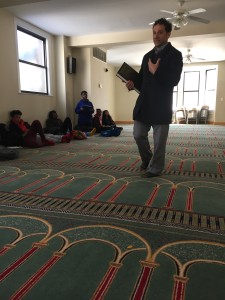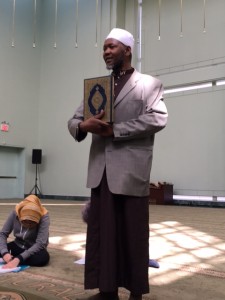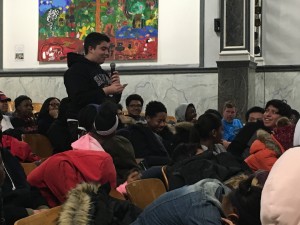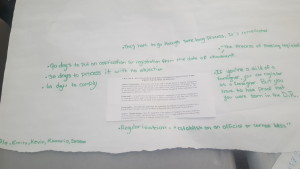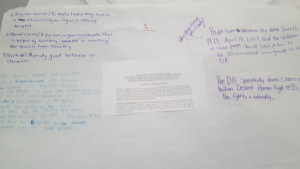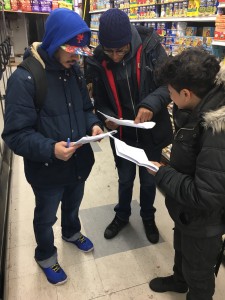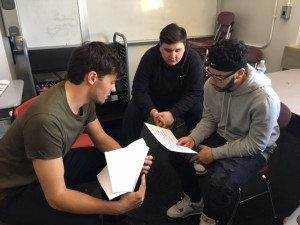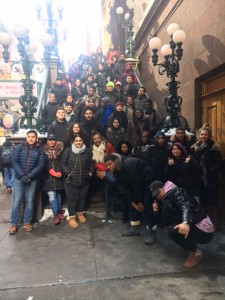A day full of learning from experts and connecting with texts!
ELA GRADE 9 FIELDWORK
Students began their day with an intensive on Islam (learning from short videos and documentaries about the central tenets of Islam) in order to generate thoughtful questions to ask the experts they visited later in the afternoon. One group visited mosques and Islamic organizations, including the Islamic Cultural Center of New York and the United American Muslim Association Mosque, talking with imams and learning about the pillars of Islam. After their visits with the experts, students debriefed about their takeaways and connections to our readings (including I am Malala and Persepolis). Another group visited the Museum of the City of New York where they got a personalized tour through the Muslims in New York exhibit, learning about how Muslims fit into the growing narrative of NY. Students debriefed about what changed, challenged, or confirmed what they already knew about Muslims or Islamic culture and made deeper connections to class texts. A last group engaged in a deeper study of the Iranian Revolution, looking at maps of the Middle East and watching short documentaries about how Iran changed during the revolution. They then welcomed guest speaker Feresteh Victory who spoke about her narrow survival of the Iranian Revolution and who inspired students in a writing workshop related to the text Persepolis by Marjane Satrapi.
ELA GRADE 10 FIELDWORK
Students continued investigating the role history has played in shaping the law removing the rights of citizenship from persons of Haitian descent living in the Dominican Republic as part of their case study around the impact of U.S. occupation on Trujillo’s reign in the DR. This included jigsawing the actual law; reading and annotating articles; analyzing a TED Talk on the importance of understanding power; viewing video clips of reactions to this law and participating in a Q & A with a Haitian activist on this issue. Today’s fieldwork allowed students to deepen their understanding of the role of legislation in shaping the direction of a country. Students were honored to meet with an activist-expert on this issue and began drafting their position papers about the law in question, to be presented at roundtables later this month.
ELA GRADE 11 FIELDWORK
Students engaged in neighborhood investigations/interviews and Socratic seminars related to the essential question for the unit which is: “To what extent do we have control over our lives?” connected to the play Fences. Students learned that a major factor that influences the direction of someone’s life is the neighborhood in which they live. Students were assigned to one of eight neighborhoods in Brooklyn (Brooklyn Heights, Park Slope, Dumbo, Williamsburg, Bed-Stuy, Crown Heights, Flatbush, Ocean Hill/Brownsville). Students first observed different dynamics and elements of the neighborhood to gain a deeper understanding of how these neighborhoods impact their residents. Then they conducted three interviews with residents of the neighborhood to gain insight as to what it is like to live there and how it impacts their lives. Finally students participated in two extensive Socratic Seminars in which they shared their data, views, opinions, and insights on the different neighborhoods visited revolving around these questions: How might the amenities or lack of amenities (housing, transportation, food, sanitation, etc…) impact the residents psychologically, socially, and/or economically? How do the other elements of the neighborhood (sense of community, safety, demographics, etc…) affect your psychological well-being? Your self-perception? Others’ perception of you? Was the neighborhood you visited similar or different to the neighborhoods in Fences? Explain. How do the residents of each neighborhood act, behave, respond as a result of where they live? Why do you think they behave this way? Is this similar or different to the characters in Fences? How might the characters from Fences feel or behave in these neighborhoods? Would their lives be different? How might this neighborhood impact the lives of future generations who live there? Make at least one specific inference with evidence that shows how a particular aspect of a neighborhood’s setting (housing, socioeconomic status, demographics, segregation) impacts its residents (psychologically, emotionally, physically, financially). Make one specific inference with evidence that shows how this same aspect of the setting in Fences impacted the characters.
ELA GRADE 12 FIELDWORK
In ELA class, students have been reading several texts and analyzing them through psychological theories (Freud, Maslow, Double Consciousness and Gender/Feminism) focusing on the learning targets: I can relate a text to a psychological theory, choosing the theory that best matches the text, and I can compare a narrative text to actual events and analyze why the playwright made certain choices and changes. One of the texts students read was excerpts from The Autobiography of Malcolm X, which students interpreted through the lens of Maslow’s hierarchy. For today’s Expeditionary Thursday, students attended a performance of X or Betty Shabazz vs. The Nation, which re-imagines Malcolm X’s widow’s lawsuit against the U.S. for his wrongful death. The play is a mix of realism and fantasy, as the story of Malcolm X’s life is told in flashbacks, including such fictional scenes as a conversation between Malcolm X and Martin Luther King Jr. After the performance, students discussed what aspects of the play related to the theories they have studied. Students then engaged in post-show workshops with visiting Teaching Artists from the New Victory Theater back at Brooklyn Collaborative. Students then had the opportunity to write about Malcolm X as a a supplementary text for their Mastery Passage PBATs (for instance, analyzing The Great Gatsby and The Autobiography of Malcolm X/Betty Shabazz with Maslow’s theory).


